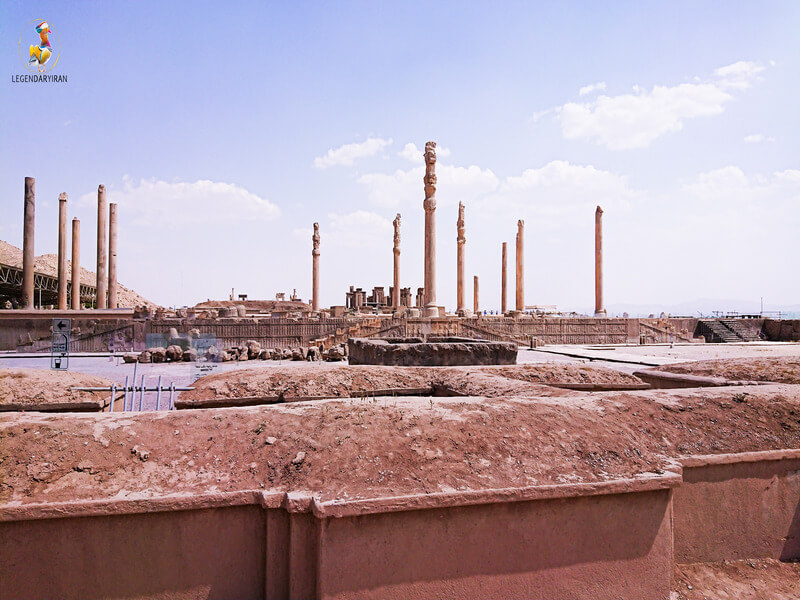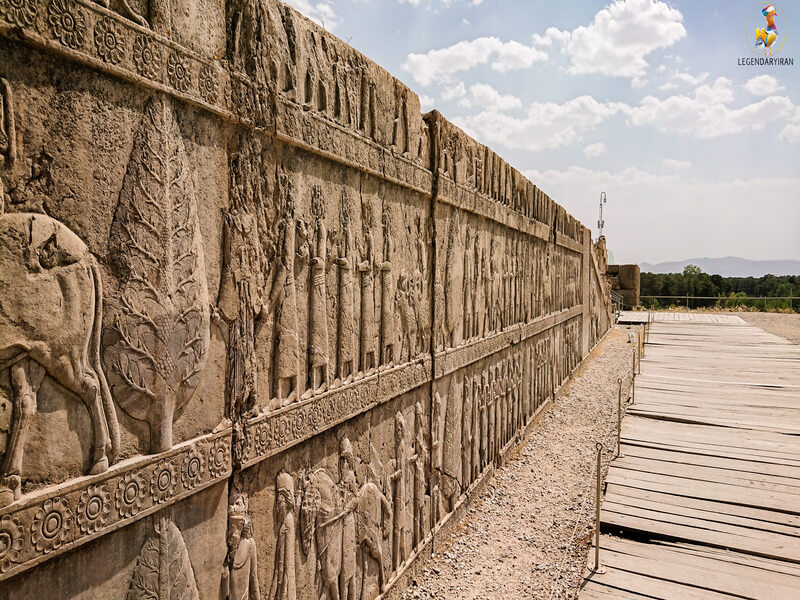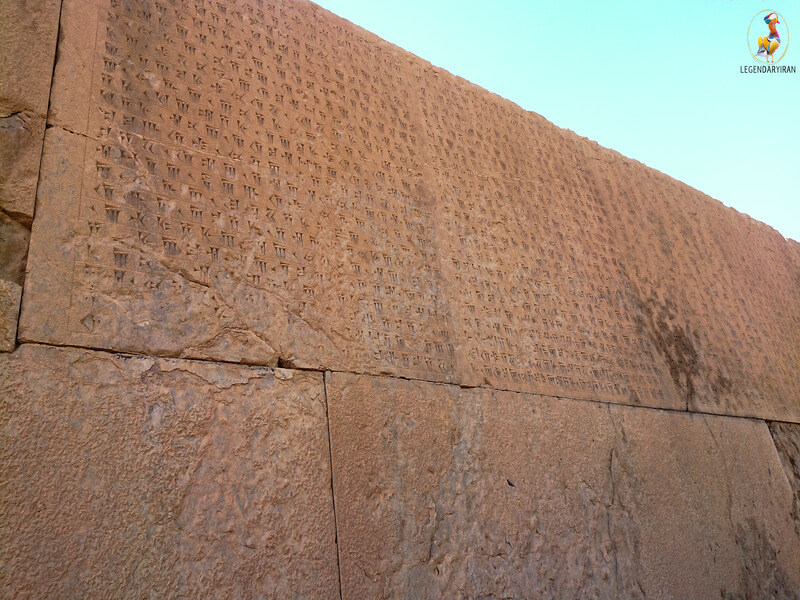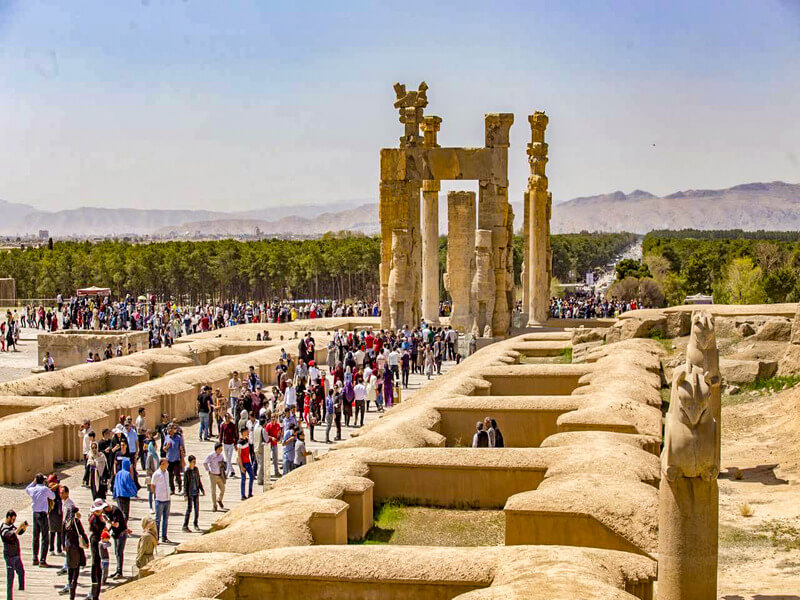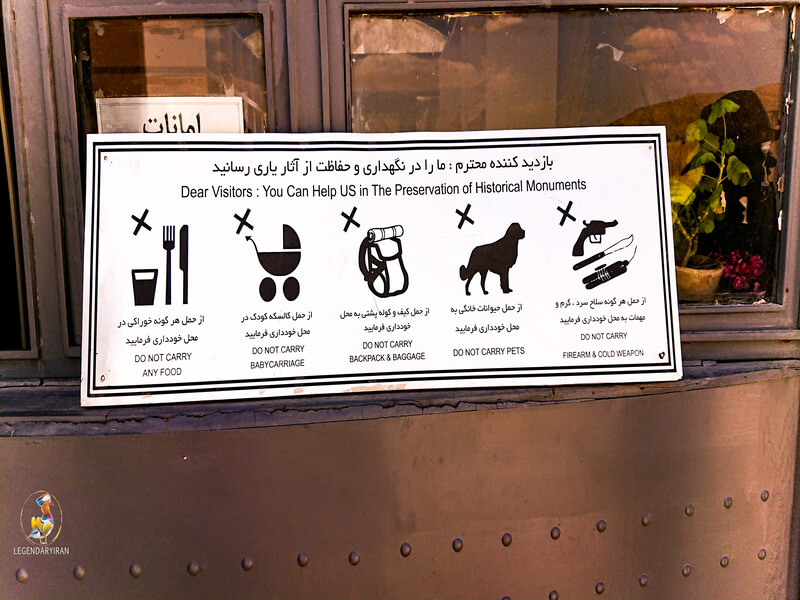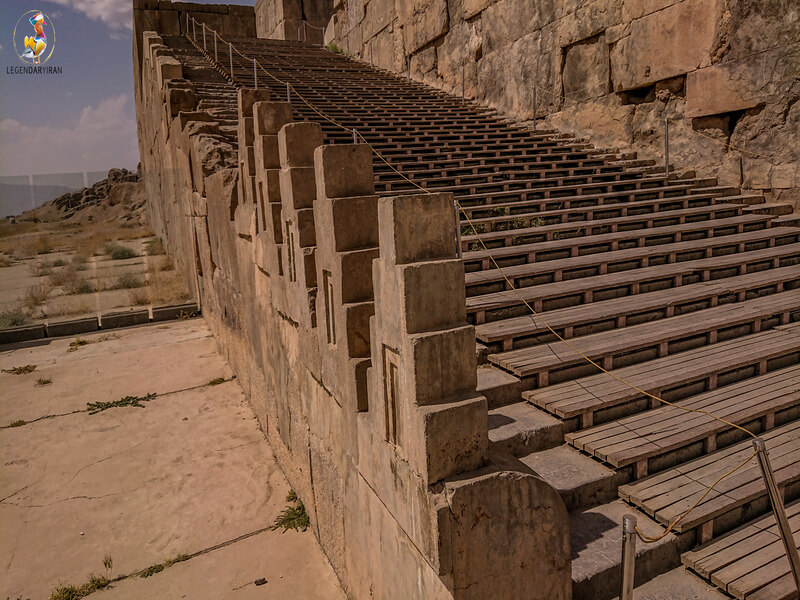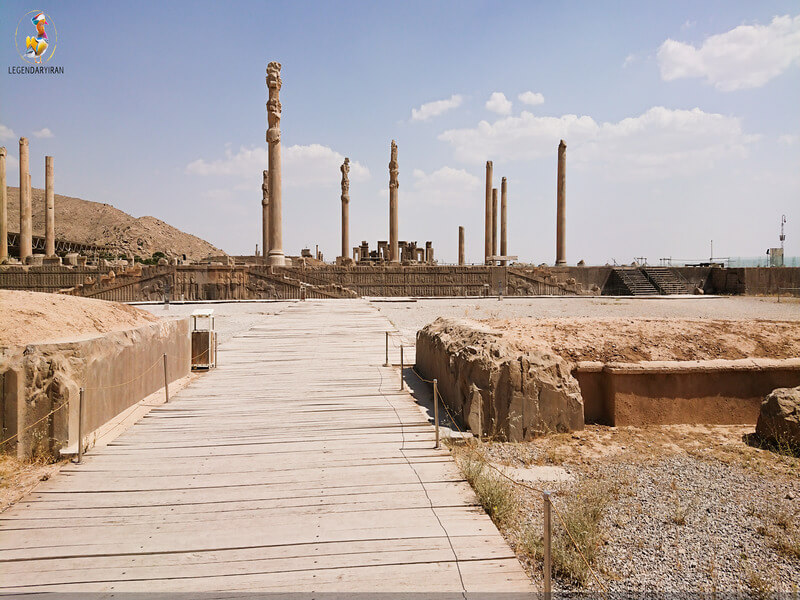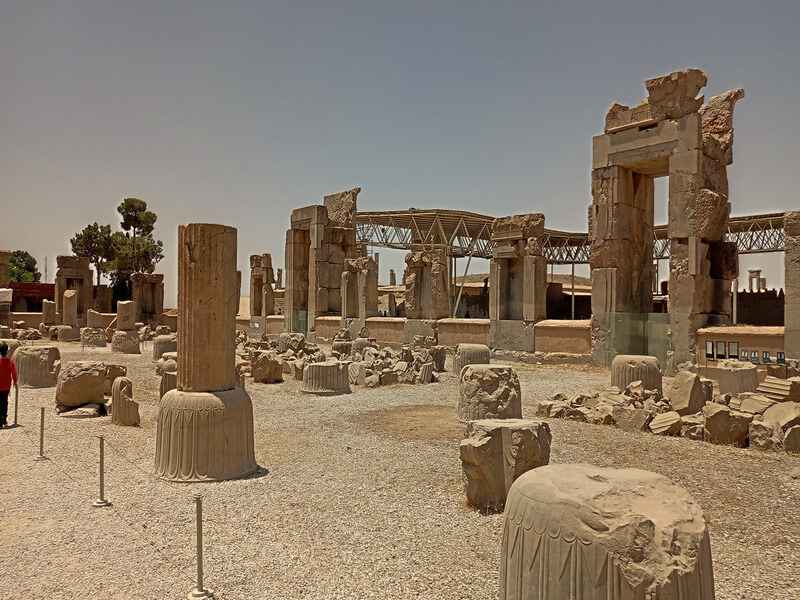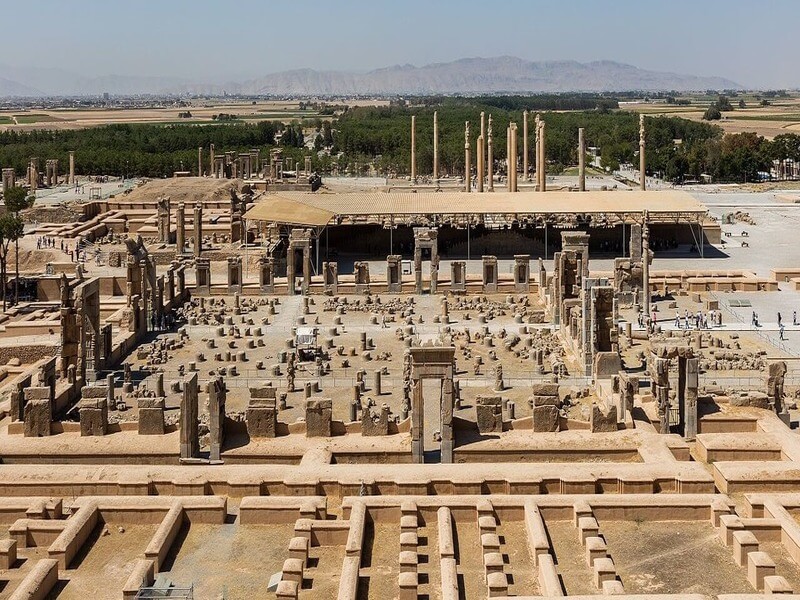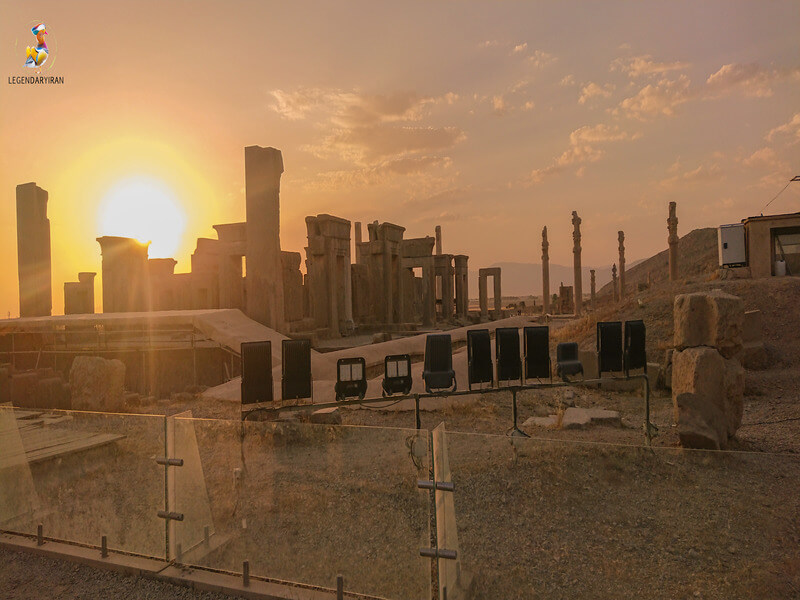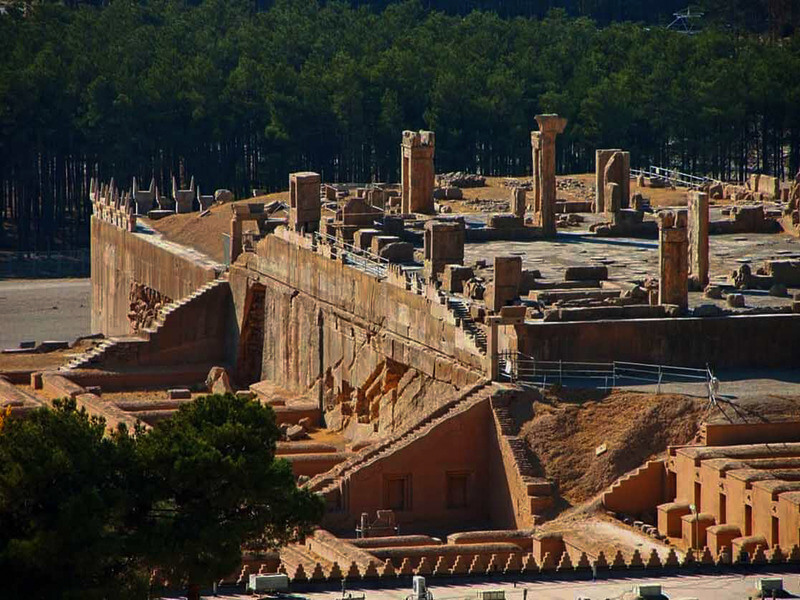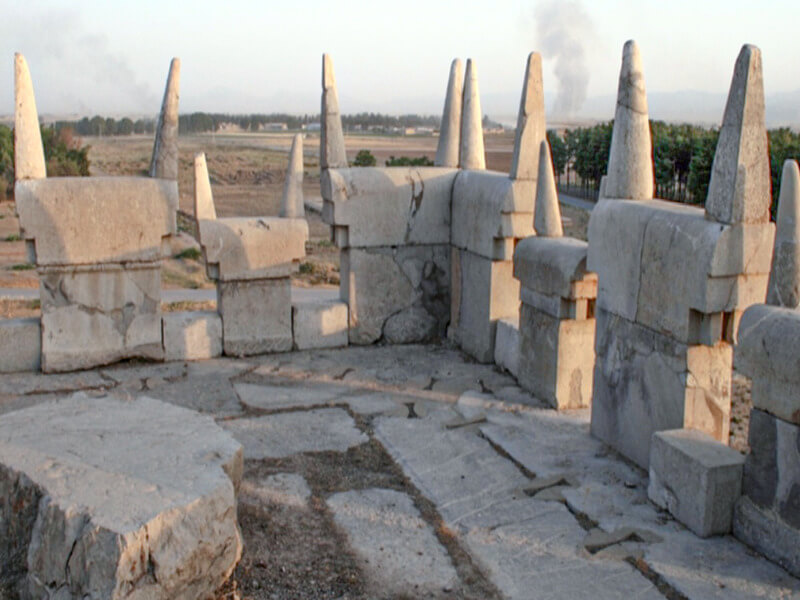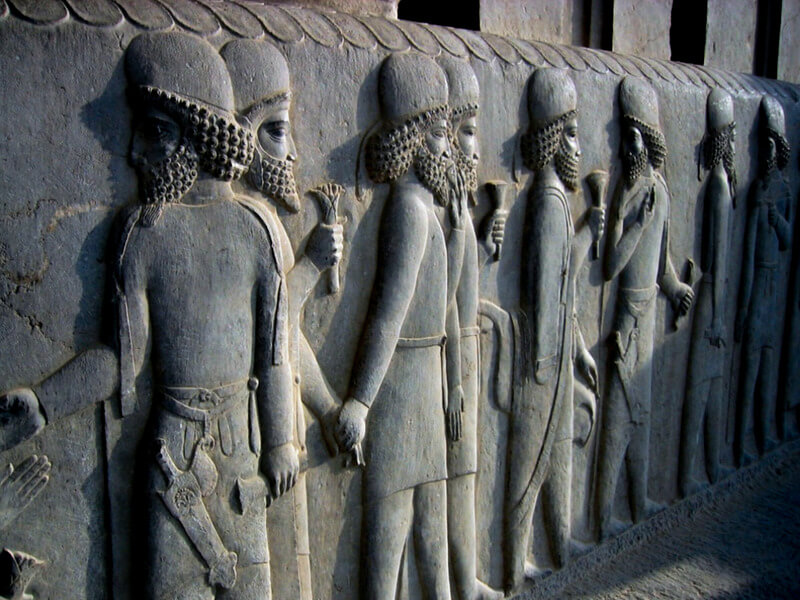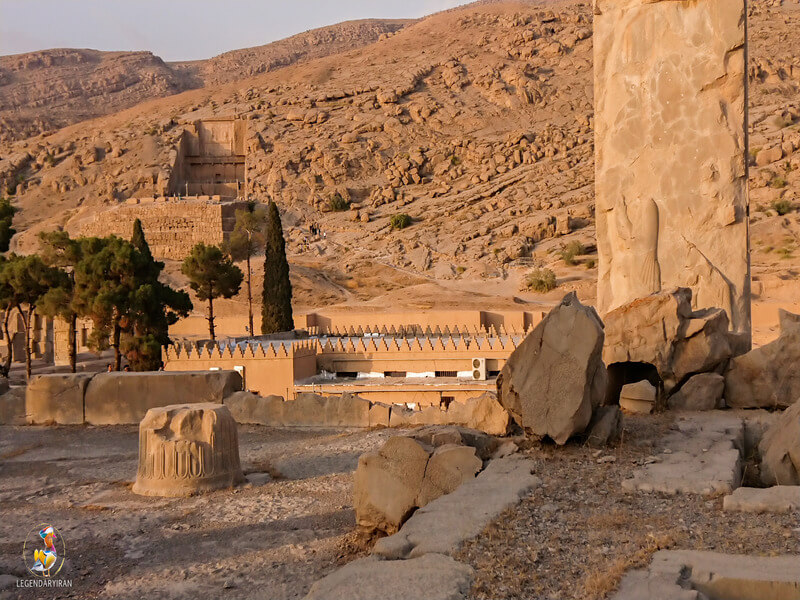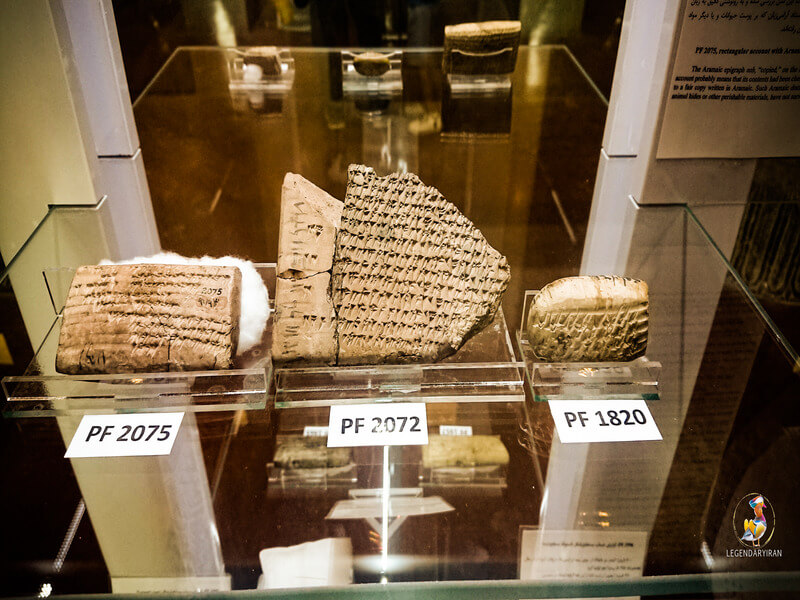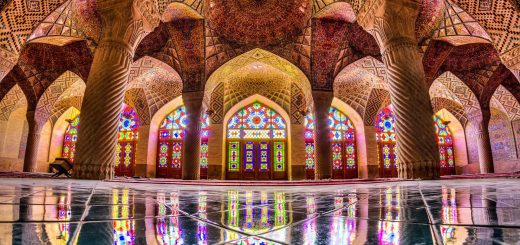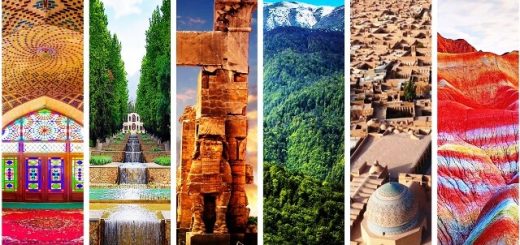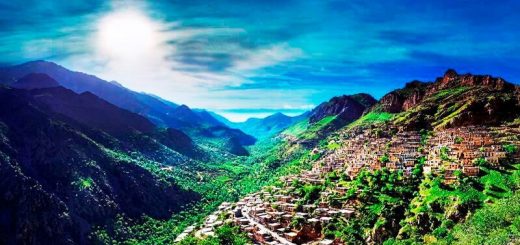Persepolis (Takht-e Jamshid)
by Maryam Kiani · November 28, 2022
Takht-e Jamshid, the Capital of the Achaemenid Empire
Persepolis, also known as Takht-e Jamshid, is an ancient Iranian symbol of grandeur and one of the best places you must visit in Shiraz. In the history of human civilization, Persepolis and its monuments are unquestionably among the most important documents.
The Takht-e Jamshid is a 2500-year-old relic of the Achaemenid Dynasty. Persepolis was the ritual capital of the Achaemenid Empire, which ruled a significant part of the eastern world during ancient times.
Detailed studies of inscriptions and works from this region have revealed the advanced civilization that existed in ancient Iran.
We invite you to join us in this article if you are interested in learning about the ancient Aryan civilization or Persepolis. Here you will find information about visiting Persepolis and its history.
Persepolis at A Glance
Persepolis is an ancient city known as a symbol of the Persian civilization worldwide. This site, with 125000 square meters, is located near Marvdasht (60 km from Shiraz) in Fars Province.
It shows the architectural splendor of the palace of the kings in the ancient Iranian era.
The columns, capitals, inscriptions, reliefs, palaces, and gates remaining on the grounds of Takht-e Jamshid are among the world’s most famous works of an ancient civilization.
The construction of Persepolis, “Parseh Polis,” meaning “Land of Persia,” was started about 25 centuries ago by Dariush The Great at the foothills of Rahmat Mountain. The construction of this majestic polis took about 120 years.
Countless architects and artists (male and female workers) from different parts of the ancient world participated in the construction of Persepolis. But what makes this historical site so valuable is how the Achaemenid kings treated their workers, who received fair wages and benefits. In other words, the advanced social laws and human rights during the Achaemenid era are surprising
Top 10 Wonders of Persepolis
1. Despite its 2,500-year-old construction, Persepolis’ architecture is incredibly complex; its structure is stable, its proportions are enormous, and its inscriptions are fabulous.
2. Slavery was prevalent in other great empires of that time, and hard works were duties of slaves. On the contrary, in Iran during the Achaemenid government, not only men and women were paid fairly, but also, the workers were insured and got various benefits.
3. The most exciting thing about Persepolis is the international nature of this ancient city. As a result, people from neighboring countries with different cultures and languages traveled to Takht-e Jamshid. As well as the tablets and reliefs, the fact that most of the inscriptions are trilingual (Old Persian, Elamite, and Babylonian) provide evidence of this.
4. According to the evidence extracted from Persepolis, during the Achaemenid period, women had social rights. They could work, be paid, and benefit from exceptional support during pregnancy and childbirth. Besides, inheritance rights were equal for men and women. This social equality in 2,500 years ago is one of the biggest wonders of the Achaemenid Dynasty.
5. To build the palaces of Persepolis, colossal stone blocks were placed on top of each other to form tall columns. There is no mortar between the stones of the columns, and they are placed on top of each other only using balanced lathes and metal brackets. Consequently, the columns left from the fire of Takht-e Jamshid still stand against various earthquakes and natural disasters.
6. Among the other interesting things in the architecture of Persepolis, we can mention the brick and clay gutters in the roofs and between the walls, open channels, and stone wells. This water and sewage piping system in this ancient polis is a sign of the intelligence of the engineers and architects of that time.
7. The extraction and transportation of large stone slabs from the mountains to the palaces are one of the significant wonders of Persepolis. Simple levers transferred the large stone slabs from the hill to the construction field. These levers could move stones weighing 250 tons.
8. Delicate carvings of reliefs show the skill of the Persian stonemasons in the past.
9. One of the strangest things in Persepolis is Darius’ message to future generations. In the four corners of the Apadana Palace, four golden tablets are found on which the message of peace and friendship for the world is engraved. Placing these tablets in different places with the same messages shows Darius Achaemenid’s determination to keep these messages forever. In addition, none of the images of soldiers, leaders, and kings in different parts of the complex show signs of captivity, war, or cruelty among people.
10. Darius the Great, Xerxes, and Artaxerxes were the three rulers involved in this ancient polis’s construction project. The construction of this fantastic building continued for 188 years until the end of the Achaemenid rule, i.e., 330 BC. Therefore, half-finished gates and palaces indicate that the magic polis’ construction was never completed.
History of Persepolis
The construction of Takht-e Jamshid dates back to 518 BC, i.e., more than 2,500 years ago. Darius I, the third Achaemenid king, ordered the construction of a vast palace in the mountains around Marvdasht. But, the different castles of Persepolis were built during his successive kings’ periods, and each palace was used for various gatherings and ceremonies.
For 188 years, workers dug mountains, transferred huge stones, and leveled foothills to build palaces out of stone.
Therefore, Persepolis still amazes designers and engineers because, even today, it is challenging to construct such a vast collection.
As mentioned, the construction and completion of the palaces of Persepolis continued until the end of the Achaemenid period. However, many parts of these buildings were built during the time of Darius I, Xerxes, and Ardeshir I.
Another interesting architectural feature of Persepolis is its water and sewage piping system. Canals were dug between streets so rainwater and running water could flow through them in specific directions.
The glory of Takht-e Jamshid lasted until Alexander the Great invaded Iran. In 334 BC, Alexander the Great attacked Iran with his troops and burned Persepolis.
In 1931, Ernst Emil Herzfeld, a German archaeologist, philologist, geographer, and historian, conducted the first scientific investigation of this ancient city appointed by the Oriental Institute at the University of Chicago. From now on, the ruins of Persepolis have been excavated many times. Many discovered works are displayed in Persepolis Museum, while others are in Iran’s National Museum. There are, however, many pieces in European and American museums.
The ancient civilization of Persepolis is a historical treasure for all people of the world, although it is located in Iran. Therefore, the ruins of Takht-e Jamshid were registered on the UNESCO World Heritage List in 1979.
Where Is Persepolis?
Persepolis Complex is located northeast of Shiraz city, near Marvdasht, in a region with good weather. The distance between Shiraz and Persepolis is 70 kilometers, while Marvdasht is 11 kilometers southwest of this historical place.
Moreover, Persepolis is close to two historical attractions: Naqsh-e Rostam, 12 kilometers from Takht-e Jamshid, and the historical complex of Pasargadae, a UNESCO world heritage site, located 79 kilometers northeast of Persepolis. As a result, you can visit these three historical attractions in one day.
How to Get to Persepolis
Shiraz is the nearest city to Takht-e Jamshid (about an hour away). In this section, we will introduce the different ways to reach Persepolis from Shiraz:
- You can take a private car with a driver from Shiraz to Persepolis, which is the most convenient but expensive option. For a sedan car, the price is approximately 40 USD (the price is subject to change frequently). To rent a car with a driver, you can contact Legendaryiran.
- Another option is to visit this historical site on the way from Shiraz to Yazd or Isfahan. Of course, if you want to go with this plan, it is better to depart Shiraz early in the morning.
- You can also take Snapp or Tapsi (Iranian online taxi) from Shiraz to Persepolis.
Important Points about Visiting Persepolis
- Nowruz and other public holidays are the busiest times for visiting Persepolis. Due to the high traffic at the complex entrance and the crowded area, visiting this complex at these times may reduce the quality of your visit. So, if possible, choose working days to visit Persepolis.
- Read more about Iran holidays
- A special show called Sound and Light Show is performed in the Takht-e Jamshid area on particular days of the year, such as Nowruz. If you are interested in this show, please contact us.
- You should pay an extra fee to visit the Persepolis Museum and participate in the Sound and Light Show.
- Visiting the historical complex of Persepolis is possible on all days of the year except on religious mourning holidays and Sizdah Bedar (the last day of the Nowruz Holiday).
- Include in your tour plan a visit to Naqsh-e Rostam, Naqsh-e Rajab, and other historical attractions near Persepolis.
- Takht-e Jamshid is located in a vast open area. So, it is better to wear a hat and sunglasses when visiting this site.
- If you visit Takht-e Jamshid during summer, plan your visit in the morning or around sunset to avoid unbearably hot weather.
- Baggage, backpacks, baby carriages, food, and pets are not permitted in this historical monument.
- It is wise to visit Persepolis and Naqsh-e Rostam on the same day, as they are close to each other but far from Shiraz.
The Best Time to Visit Persepolis
Visiting Persepolis in hot seasons can be annoying due to the direct sunshine in the open area. So, the best time to visit Persepolis is from September until the end of April.
Read more about the best time to visit Shiraz
Also, it is better to visit this attraction early in the morning or afternoon when the weather is cooler. Cloudy days are also ideal for visiting Persepolis.
On the other hand, in the cold seasons, this historical site and its surrounding area are chilled after sunset. So, you need to wear appropriate clothes.
Visiting Hour and Entrance Fee of Persepolis and Its close-by Attractions
Visiting Persepolis in hot seasons can be annoying due to the direct sunshine in the open area. So, the best time to visit Persepolis is from September until the end of April.
Read more about the best time to visit Shiraz
Also, it is better to visit this attraction early in the morning or afternoon when the weather is cooler. Cloudy days are also ideal for visiting Persepolis.
On the other hand, in the cold seasons, this historical site and its surrounding area are chilled after sunset. So, you need to wear appropriate clothes.
Different Parts of Persepolis
The site of Persepolis consists of different sections, including palaces, gates, staircases, bas reliefs, etc. A staircase at the complex’s entrance leads to a vast platform where the ruins of the splendor palaces are at a foothill. In this section, we introduce different parts of the Persepolis Complex.
Entrance Staircase of Persepolis Complex
The entrance staircase consists of two symmetrical rows of stairs. In a zigzag pattern, the stairs lead to the top of the vast area of palaces at the height of 12 meters. You can easily climb these stairs because they are short.
A large stone block is carved into four or five steps, and the steps are fixed to each other without mortar. The end of the stairs leads to the Gate of Nations.
Gate of Nations
Right after the entrance staircase to Persepolis is a small palace called the “Gate of Nations.”
Why is it called the Gate of Nations? Because as the entry gate to this ancient Persian city, it welcomed representatives from different nations.
The gate’s construction dates back to Xerxes, the fourth king of the Achaemenid Empire.
The present Gate of Nations is a ruin of a palace with tall brick walls and four tall columns, and three entrances. The columns of the Gate of Nations are currently among the most intact columns remaining in Persepolis. The main hall is over 600 square meters, the roof height is 18 meters, and the column height is around 16 meters. On both sides of the western gate are statues of two big bulls facing the visitors upon entering the area.
The statue of these bulls, which was widely used in ancient Iran, is known as the Sphinx. Their heads and faces are decorated with rectangular beards, curly hair, and flowers, and they evoke a running posture. It is said that these statues were constructed to impress visitors upon arrival. Stone inscriptions in cuneiform on top of the statues, in Old Persian, Elamite, and Babylonian, indicate that Xerxes built the palace.
Stepping inside the palace through the western gate, you find yourself in a large waiting hall with four columns surrounded by a platform.
Like the western gate, the eastern gate has Sphinx with human heads symbolizing wisdom, a bull body representing power and blessings, and eagle wings indicating freedom and power. This gate leads to Hundred Pillar Palace (Sad Sotoun Palace). There was once a soldier-passing street between this gate and the Sad Sotoun Palace, known as Sepahian Street, which means Soldier Street.
Finally, the Gate of Nations’ southern entrance opens to the Apadana Palace’s northern courtyard.
Apadana Palace (The Audience Palace)
With a capacity of more than 10 thousand people, the Apadana Palace, also known as the “Audience Palace of Darius and Xerxes,” is a majestic monument at Persepolis. Built by order of Darius I, Xerxes, its construction took nearly 30 years. Interestingly, fundamental similarities have been found between this palace and Dariush’s palace in Susa.
Only 14 columns remain out of the 72 in the palace. The heads of these 24-meter-tall columns are decorated with statues of two-headed bulls. Moreover, a gutter system was installed on the adobe walls to prevent the roof from collapsing due to rainwater accumulation.
Also, being three meters higher than the courtyard, Apadana Palace is connected to the surrounding area by two staircases decorated with valuable reliefs and inscriptions.
Notably, the carvings on the eastern porch of Apadana Palace are among the most beautiful carvings of the Achaemenid period: two rows of similar stairs with curved edges and portraits of soldiers.
We can also mention the bas reliefs of people of different nations bringing gifts for the Achaemenid king on the walls of the eastern porch. Archaeologists have determined their nationality from their clothes, presents, and appearance.
The eastern porch is also decorated with rectangular frames with 12-petal flowers, winged rings, tall palms, and Sphinx. Each of the carved images was a special symbol; Palm trees have been symbols of blessing, Sphinxes are guardians, and the eagle’s wings and lion’s body symbolize the power and greatness of the Achaemenid Empire, while the winged ring signifies royal power.
Sad Sotoun Palace (The Throne Hall)
Sad Sotoun Palace, meaning “The Hall of a Hundred Columns,” is another big palace in Persepolis. It is known by this name because of the 100 columns in its central hall.
Xerxes constructed this palace east of the Apadana Palace, and Ardeshir I, his successor, completed it.
The main hall has an area of more than 4600 square meters and is bigger than the main hall of the Apadana Palace, but its height is two meters less.
The Throne Hall columns were 14 meters high with carvings and bull heads; two of them were taken to the Chicago Museum in 1930.
Furthermore, there were carvings at the entrance gates, some of which remain today, such as that of Ardeshir Shah sitting on his throne at the northern gate. Archaeologists have found other examples of this relief with slight differences in the Treasury Palace and the Three Gate Palace of Takht-e Jamshid.
The Treasury of Persepolis
Near the Throne Hall is the Treasury of Persepolis, which was used to store the valuables of the Achaemenid kings. Thick walls and narrow roads surround the ruins of this large building. This monument is one of the first buildings built in this historic city and was constructed during the time of Darrius I.
In the Treasury, you can see column bases, two statues of the double-headed eagle column, and two reliefs on marble.
Besides, Elamite inscriptions describing the rights and salaries of workers have been found in the Treasury section. It consists of more than 600 inscriptions, which provide:
- Detailed information on the division of labor.
- The nationality of workers.
- Equal rights for men and women.
- …
Moreover, they found patterns decorated with the seal of employers, which are very important historical documents. This building was damaged by a massive fire that destroyed many documents and treasures.
Tachar (Palace of Darius the Great)
Darius I Palace, also called Tachar or Tachara Palace, on the southwest of Apadana Palace, is one of the first buildings of Persepolis.
Tachar Palace is also known as Dariush’s Winter Palace, as it faces the south and the sun. Additionally, due to its elegant architecture and polished stones, this palace is also called the “Mirror Hall.”
The columns were all made of wood, and none are left today, while the stone gates, inscriptions, and reliefs remain.
The reliefs on the walls depict servants carrying lambs and motifs such as Ahuramazda, the king, and the Sphinx. There is also an inscription in ancient Persian praising Ahura Mazda and expressing Achaemenid majesty.
According to the documents, precious stones and gold sheets were used in the decorations of the sculptures. Many pieces of discovered sculptures are kept in the National Library of France today.
Interestingly, you can find relics from the post-Achaemenid period on the walls, such as epitaphs from Sassanid Shapur II, Azad al-Dawlah Deilami, Timurid prince, etc.
Hadish Palace (Xerxes Palace)
Hadish Palace is located in the south of the area of Takht-e Jamshid. Although archaeologists have estimated that this palace was by order of Xerxes, there is evidence in the inscriptions that refers to the time of Darius I.
The area of the Hadish Palace is about 1500 square meters, and it has access to the Dariush Palace and H Palace through its western and northeastern stairs. The western staircase still stands, but the eastern staircase has been ruined.
On the palace’s main western and eastern portals, the image of Xerxes and inscriptions in Elamite, ancient Persian, and Babylonian languages can be seen. In these inscriptions, the name of Xerxes, as the builder of this palace, was found.
The Hadish Palace was the private residence of Xerxes and had a scenic view of Marvdasht Plain.
Unfortunately, the palace was damaged drastically during Alexander’s attack.
The Palace of Ardeshir I (H Palace)
H Palace, or the Palace of Ardeshir I, is on the west side of Hadish palace. There is a congress on the Western and Southern edges of the main building in the form of bull heads and horns. The meaning of these bull-head congresses is not clear, but they are unique in Persepolis. These congresses are decorated with patterns such as arrows and crucifixes.
Also, an inscription in the ancient Persian language can be seen between two groups of sixteen Persian spearmen. Behind each group, the same inscription is repeated. This inscription express that Artaxerxes was a follower of the Ahurai religion (Zoroastrian Religion), like his father, Xerxes, and his grandfather Darius the Great.
Three-Gate palace (Central Palace)
Three-Gate Palace (Se Dari in Persian) is a palace with three entrances in the center of the Persepolis area that is also called the “Central Palace”.
Further, the Central Palace Hall was a place for official meetings with foreign guests and court dignitaries, and its stairs were decorated with pictures of the court dignitaries. For this reason, this palace is also called the “Council Palace.”
The images of the soldiers, court elders, kings, different animals, and beasts can be seen in different parts of this palace.
Interestingly, there was a circle in the center of the hall on the stone bed, and the sunlight shined vertically at this point at sunrise.
Finally, according to the evidence, this palace was constructed at the end of the reign of Xerxes and completed by Artaxerxes I.
Royal Tombs
On the mountainside overlooking the site of Persepolis, the remains of two stone tombs can be seen in a cross shape.
According to religious beliefs during the Achaemenid period, the human corps should not contaminate the three sacred elements of water, earth, and fire. As a result, they sought alternative burial methods such as Zoroastrian crypts (Dakhmeh), stone tombs, Ostudan (where corpses’ bones were stored), and large stone chests for mummified bodies.
The stone graves in Persepolis belong to two Achaemenid kings, Artaxerxes II and III, which are like the stone tombs of Naghsh-e Rostam.
Notably, Darius the Great, his son (Xerxes), and his grandsons (Artaxerxes I and Darius II) chose Naghsh-e Rostam (near Persepolis) to build their stone tombs.
Persepolis Museum (Harem or Queen Palace)
The Persepolis Museum is the oldest museum building in Iran, which has been changed to its modern form by restoring the Queen’s Palace (Malakeh Palace) in Persepolis. The construction of this museum, also known as the Achaemenid Museum, began in 1932 by Professor Herzfeld, who led the excavations in Persepolis. The red Saroj in the interior decorations of Persepolis Museum is symbolic of the building’s old structure.
The Queen Palace, built by King Xerxes, includes the main hall and several rooms decorated with carvings depicting King Xerxes, his attendants, and mythical creatures. The main hall has twelve wooden pillars supporting the ceiling, and each pillar has a two-headed cow statue.
In the Persepolis Museum, you can see the objects found in the Persepolis area; these include construction tools, clay rhytons, seals, burnt curtains, containers, etc. Also, among the most interesting sculptures in the museum are the statues of two women, which date back to ancient Egypt but, suprisingly, were discovered in Persepolis.
The number of objects in the museum’s storage reaches more than 5,000, while the displayed objects are about 170 that are alternately replaced by each other. As a result, you can visit this museum again and again to see new things.
In addition to the historical works from the Achaemenid period, the museum also displays objects from before and after this period.
Please ask your questions or share your comments regarding visiting Persepolis in Shiraz. We appreciate your valuable comments, and they will also be helpful to others.
Finally, please leave your comments if you have any other information or questions about Persepolis.
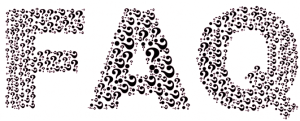
Most Frequent Questions and Answers about
Persepolis
Like this article?
Subscribe To Our Newsletter
Get updated articles about Iran trip


